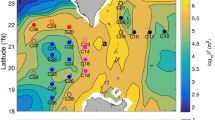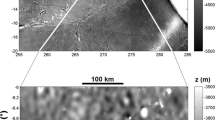Abstract
The deep and bottom waters of the Japan Sea (depth ≳ 1000 m) are characterized by low temperature and weak stratification. In the Japan Basin, especially, the bottom water (depth ≳ 2500 m), called the Japan Sea bottom water (JSBW), with a thickness of over 1000 m, is mostly homogeneous. Several studies in recent decades have suggested that the potential temperature of the JSBW is gradually increasing, even though the thick homogeneous vertical structure is being maintained. Although downward mixing of heat from the upper layer was believed to be responsible for this characteristic feature, our microstructure measurements found that the intensity of turbulence in the JSBW is too weak to explain the formation of the gradually warming thick homogeneous layer. By use of a one-dimensional numerical model we demonstrated that this characteristic feature of the JSBW can be reasonably explained on the basis of a combination of geothermal heating from the seabed and an appropriate horizontal supply of cold water to the bottom layer.







Similar content being viewed by others
References
Chandrasekhar S (1961) Hydrodynamic and hydromagnetic stability. the Clarendon Press, Oxford, p 654
Gamo T (2011) Dissolved oxygen in the bottom water of the Sea of Japan as a sensitive alarm for global climate change. Trends Anal Chem 30:1308–1319
Gamo T (2014) Excess 222Rn profiles in the bottom layer of the Japan Sea and their implication for bottom water dynamics. Prog Oceanogr 121:94–97
Gamo T, Horibe Y (1983) Abyssal circulation in the Japan Sea. J Oceanogr Soc Japan 39:220–230
Gamo T, Nozaki Y, Sakai H, Nakai T, Tsubota H (1986) Spatial and temporal variations of water characteristics in the Japan Sea bottom layer. J Mar Res 44:781–793
Kim K, Kim K-R, Min D-H, Volkov YN, Yoon J-H, Takematsu M (2001) Warming and structural changes in the East (Japan) Sea: a clue to future changes in global oceans? Geophys Res Lett 28(17):3293–3296
Kim K-R, Kim G, Kim K, Lobanov V, Ponomarev V, Salyuk A (2002a) A sudden bottom-water formation during the severe winter 2000–2001: the case of the East/Japan Sea. Geophys Res Lett 29(8):1234. doi:10.1029/2001GL014498
Kim K-R, Kim K, Kang D-J, Volkov YN, Yoon J-H, Takematsu M (2002b) The changes in the East/Japan Sea found by CREAMS. Oceanog. in Japan 11(3):419–429 (in Japanese with abstract in English)
Kim Y-G, Lee S-M, Matsubayashi O (2010) New heat flow measurements in the Ulleung Basin, East Sea (Sea of Japan): relationship to local BSR depth, and implications for regional heat flow distribution. Geo-Mar Lett 30:595–603. doi:10.1007/s00367-010-0207-x
Matsuno T, Wolk F (2005) Observations of turbulent energy disspation rate ε in the Japan Sea. Deep Sea Res II 52:1564–1579. doi:10.1016/j.dsr2.2004.06.037
Minami H, Kano Y, Ogawa K (1999) Long-term variations of potential temperature and dissolved oxygen of the Japan Sea Proper Water. J Oceanogr 55:197–205
Mori K, Matsuno T, Senjyu T (2005) Seasonal/spatial variations of the near-inertial oscillations in the deep water of the Japan Sea. J Oceanogr 61(4):761–774. doi:10.1007/s10872-005-0082-7
Osborn TR (1980) Estimates of the local rate of vertical diffusion from dissipation measurements. J Phys Oceanogr 10:83–89
Park Y-G, Park J-H, Lee HJ, Min HS, Kim S-D (2013) The effects of geothermal heating on the East/Japan Sea circulation. J Geophys Res Ocean 118:1893–1905. doi:10.1002/jgrc.20161
Senjyu T, Aramaki T, Otosaka S, Togawa O, Danchenkov M, Karasev E, Volkov Y (2002) Renewal of the bottom water after the winter 2000-2001 may spin-up the thermohaline circulation in the Japan Sea. Geophys Res Lett. doi:10.1029/2001GL014093
Senjyu T, Shin TH-R, Yoon J-H, Nagano A, An H-S, Byun S-K, Lee C-K (2005) Deep flow field in the Japan/East Sea as deduced from direct current measurements. Deep Sea Res II 52:1726–1741. doi:10.1016/j.dsr2.2003.10.013
UNESCO (1983) Algorithms for computation of fundamental properties of seawater. UNESCO technical papers in marine sciences 44:53
Yamano M, Uyeda S, Uyeshima M, Kinoshita M, Nagihara S, Boh R, Fujisawa H (1988) Report on DELP 1985 Cruises in the Japan Sea : Part V : heat flow measurements. Bull Earthquake Res Inst 62(4):417–432
Acknowledgments
The data used in this study were obtained during the research cruises of R/V Tansei-Maru, KT-10-27, KT-11-19 and R/V Hakuho-Maru, KH-10-2. We would like to express our appreciation to the captain, officers, and crew for their dedication and cooperation. We would like to extend our gratitude to Seiji Nishimura and all the participants in the cruises. This work was supported by JSPS KAKENHI grant number 22340139.
Author information
Authors and Affiliations
Corresponding author
Rights and permissions
About this article
Cite this article
Matsuno, T., Endoh, T., Hibiya, T. et al. Formation of the well-mixed homogeneous layer in the bottom water of the Japan Sea. J Oceanogr 71, 441–447 (2015). https://doi.org/10.1007/s10872-015-0303-7
Received:
Revised:
Accepted:
Published:
Issue Date:
DOI: https://doi.org/10.1007/s10872-015-0303-7




